It dawned on me about two months after accepting this role as the 12th CSEG Distinguished Lecturer that, aside from being an honour to be chosen, it might be a significant commitment. Dr. Don Lawton (2016/2017 CDL Committee Chair and 2013 CSEG Distinguished Lecturer) had sent out 30-plus emails, copying me on each one, inviting participation in the CDL tour, then left the rest up to me. I gathered advice from previous lecturers, combined spreadsheets, updated contacts, looked at a map of North America to get the lay of the land, answered all the email replies with a “thanks for your interest, I’ll get back to you as my schedule evolves” and turned to Google for some modern help building that schedule.
The schedule came together bit-by-bit with a generous amount of flexibility and understanding from the organizers at each venue. And once I started showing up in person, those same organizers were exceptional hosts, providing a wide range of assistance, from making bookings to calling taxis to recommending sights and restaurants, to escorting me to those interesting sights and local restaurants. At every stop, I was treated to informal presentations of projects by students and professors full of enthusiasm and pride – it was impressive and inspiring. I was also treated to food of some kind at most venues (good thing I like pizza). And the weather was glorious everywhere – even St. John’s in November!
The tour started in October, 2016 on the east coast of Canada at Acadia University in beautiful Wolfville, N.S., at a beautiful time of year, followed by several more Maritime stops in Nova Scotia and New Brunswick. After my lecture at Dalhousie in Halifax, I was invited to meet with their newly formed Association for Women Geoscientists for a chat about specific perspectives and challenges facing women in the industry. While I didn’t always draw attention to the point, the fact that I was the first female distinguished lecturer carried a certain amount of responsibility to engage with young women looking for role models and inspiration. The interesting thing for me with most of those encounters was that the inspiration was usually mutual.
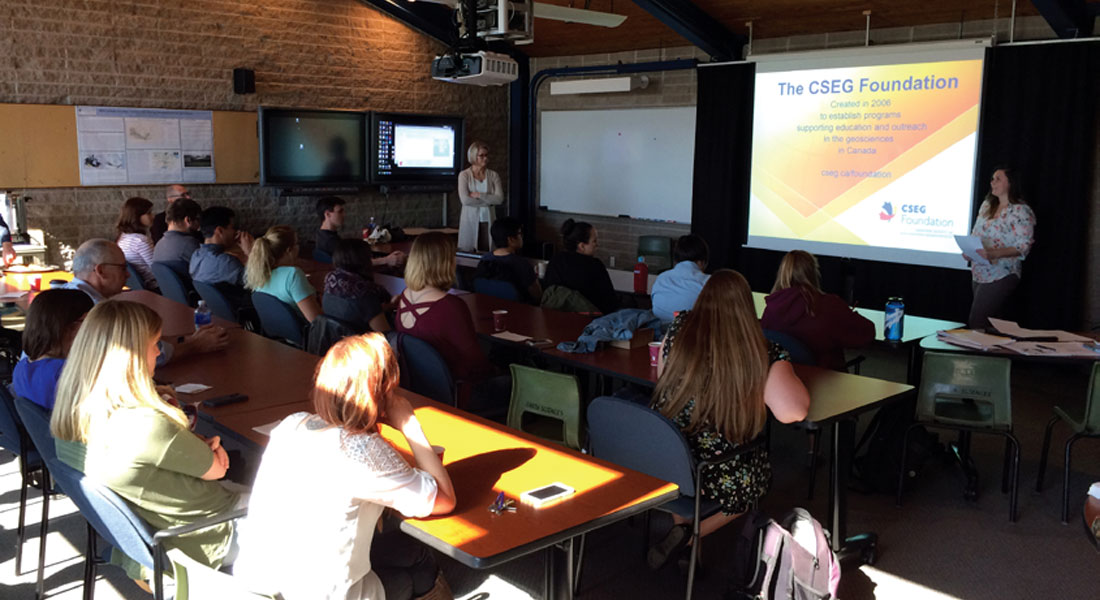
In Fredericton, my lecture was hosted at the historic University of New Brunswick Geology and Forestry building which also houses the impressive Quartermain Earth Science Centre. My host there, Karl Butler, and his students focus on researching geophysical methods for a variety of applications including groundwater management and mine imaging. As at many of my presentations, several of the audience were geologists or geology students and could relate to the integration focus of my presentation, especially the need to incorporate all the available data and insights.
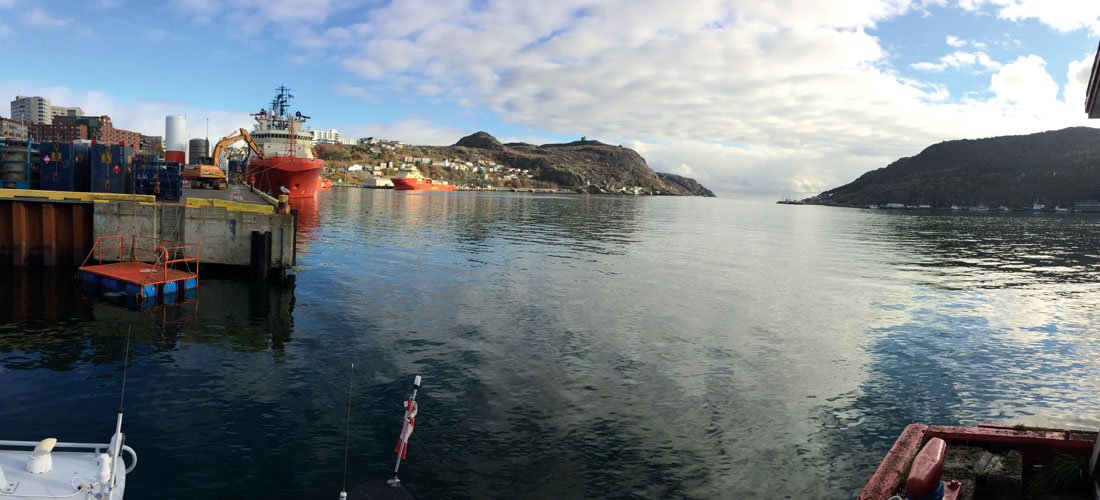
The next leg of the tour in November was the most logistically challenging with 9 stops in 3 provinces in 14 days. First stop: St. John’s. There was a market in the courtyard behind my hotel with stalls selling game birds, hares, mead (yes, mead), leather goods and what looked like horseshoeing tools. Not having been to Newfoundland before, I took it in stride, thinking, ‘how quaint this province is’. It was only when I noticed the man in stocks that I looked around for the cameras… Indeed. Movie set.
In spite of my original mistaken impression, Newfoundland is part of the modern world, with a world-class university, Memorial, where I was hosted by Dr. Alison Malcolm. I met several of Dr. Malcolm’s students who have come from around the globe to work with her on problems ranging from imaging to inversion to uncertainty. From St. John’s, I flew to Québec City – via Toronto (not the most direct route, but I trusted the logic). Arriving late at night, I checked into the hotel and then checked out a few hours later as I left to walk the few blocks to INRS (Institut National de la Recherche Scientifique). INRS is part of the Université du Québec network and has four centers for scientific research and graduate studies in Québec. After my presentation, and an elegant French bistro lunch with my host, I caught a taxi back to the airport for the flight to Ottawa.
My lecture in Ottawa, held at the Geological Survey of Canada (GSC) building, was jointly hosted by NRCan, Carleton University and the University of Ottawa as part of the GSC Logan Club series of talks. As always, I was warmly welcomed and, after the presentation, treated to lunch at an excellent local restaurant with my host, Dr. Peter Morse, and his colleague. Another quick visit, as I was scheduled to present at Queen’s University at 4pm that same day. This time, I rented a car, and set out on a road trip to Kingston, returning to my hotel in Ottawa late at night after a very short few hours with Dr. Alexander Braun, students, faculty and Queen’s alumni. I decided after that experience that two talks in one day was too many.
The extremely early flight the next morning took me to Sudbury (via Toronto) where Dr. Richard Smith (2010 CSEG Distinguished Lecturer), met me at the airport and described the unique impact geology and mineral exploration in the Sudbury area on the long drive into town. It was enlightening to learn about the applications of geophysics in non-seismic mining environments and I got to see the giant nickel!
Back to Toronto, where I changed planes and hopped (literally – gate-to-gate was 37 minutes) to Windsor, my taxi following the flight crew to the hotel, only to meet them again on the afternoon flight to Toronto the next day. The University of Windsor is a beautiful campus along the Detroit River – the Detroit office towers across the river were glowing spectacularly with the reflected sunrise on the day I was there. Dr. Joel Gagnon, students and faculty at Windsor were obviously very interested and engaged in the geoscience, engineering and integration concepts I talked about, and I regret having to rush the potentially lively discussion after my presentation (over coffee and donuts), because my cab was waiting.
From Toronto, I caught the train to London and the University of Western Ontario where I was met by Dr. Sheri Molnar and Dr. Gerhard Pratt (2008 CSEG Distinguished Lecturer and a world expert on full waveform inversion). I was happy to have a full afternoon and evening of interesting discussion, lecturing and socialization, before being conveniently delivered to the train station for the comfortable ride back to Toronto. Not so comfortable on the bus the next day to and from Waterloo in freeway stop-and-go traffic. However, the silver lining was that my last lecture was, finally, actually in Toronto. (I felt a little like I was in a movie cross between ‘Groundhog Day’ and ‘The Terminal’, where I was doomed to keep arriving back in the D-gates of Terminal 1, until I perfected something and the doors would finally open and let me out). At U of T, Dr. Bernd Milkereit (2014 CSEG Distinguished Lecturer and Chair of the 2018 CDL committee) organized and hosted the lecture and lunch. That completed this leg of the tour and I spent the weekend visiting with family and reflecting on the hectic, but thoroughly enriching, experience thus far. I was still less than halfway through the program.

Short trips took place in December and January, to several universities and institutions in Western Canada, including a fully organized day of visiting and reviewing projects with small groups of students at UBC, many studying under Dr. Felix Hermann, director for the Seismic Laboratory for Imaging and Modelling (SLIM). A highlight for me was returning to the University of Victoria, my alma mater, to present in one of the lecture halls I sat in as a young physics student, and visiting the Pacific Geoscience Centre where the legacy of my famous honours thesis advisor, the late Dr. Ted Irving, was obviously still celebrated and influential. I also made the C-train trip from downtown Calgary to the University of Calgary to deliver the lecture to the hometown crowd, which included the single biggest benefactor to the Distinguished Lecture program, Andreas Cordsen.
Despite having made a private promise not to do two lectures in one day again, I did just that in Edmonton. I presented to a group of undergrad and graduate students of Dr. Mauricio Sacchi (2016 CSEG Distinguished Lecturer) and Dr. Doug Schmidt (2018 CSEG Distinguished Lecturer) at the University of Alberta. My schedule for the day was coordinated with the Western Inter-University Geosciences Conference (WIUGC), which was taking place that week in Edmonton. I had a late afternoon time slot for my WIUGC lecture and was very pleased to see the large group of student geoscientists from across Western Canada. Right after the lecture was the Challenge Bowl and social time to mix and chat with the students. Several of the questions and comments were understandably related to job prospects in the industry and how to stand out in a currently over-crowded field. Many wanted to know what things were like in Calgary and some raised environmental or even political questions, which I tried to address tactfully and objectively.
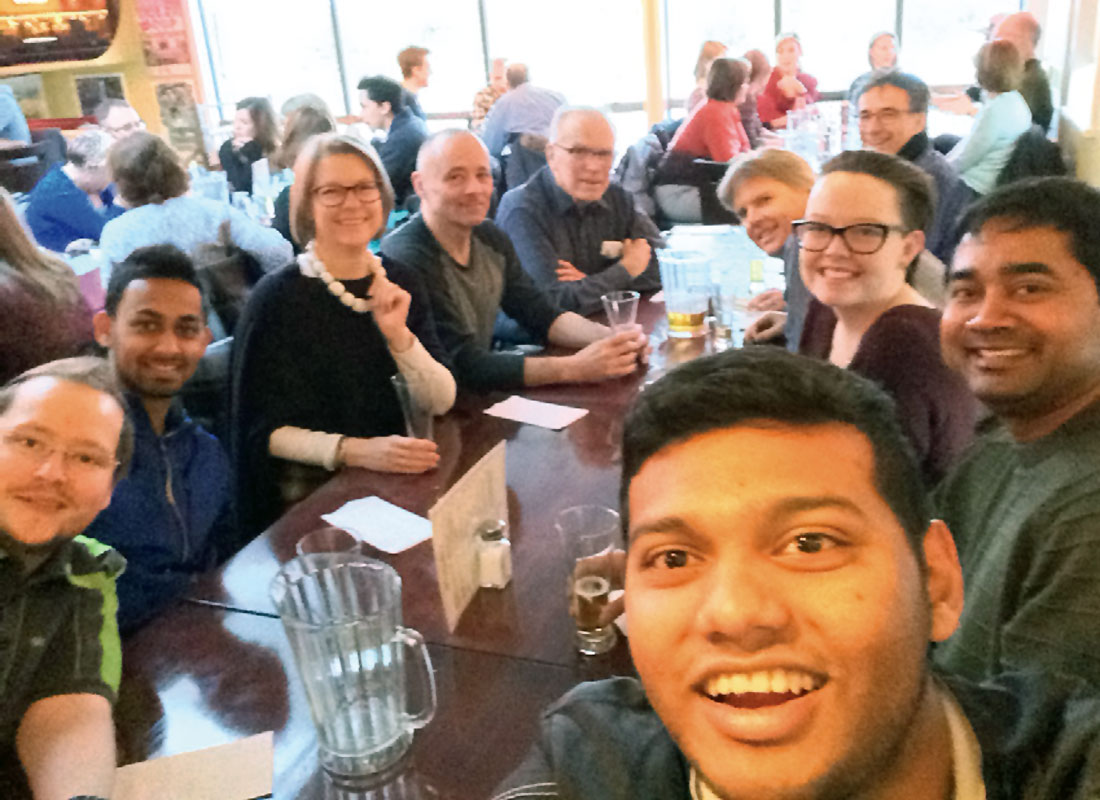
The final leg of the Canadian portion of the tour went through ‘Middle’ Canada (Winnipeg, Thunder Bay and Saskatoon) in late January – the dead of winter. Although the days were short and cold, the sun was out (my good luck with weather was holding) and the audiences were warm and appreciative. In both Winnipeg and Saskatoon, I experienced something new: someone in the audience who came to my lecture for the second time! In Thunder Bay, I was picked up at the airport (taxis were scarce because it was Super Bowl Sunday) by the owner of the historic (yet surprisingly large) Prince Arthur hotel on the shores of Lake Superior. It turns out that they have hosted several Syrian refugee families in the hotel, for months at a time, while they built their new lives. Indeed, across the hall from my room, a couple of curious little Syrian girls stood in their door and watched me come and go with shy smiles on their faces.
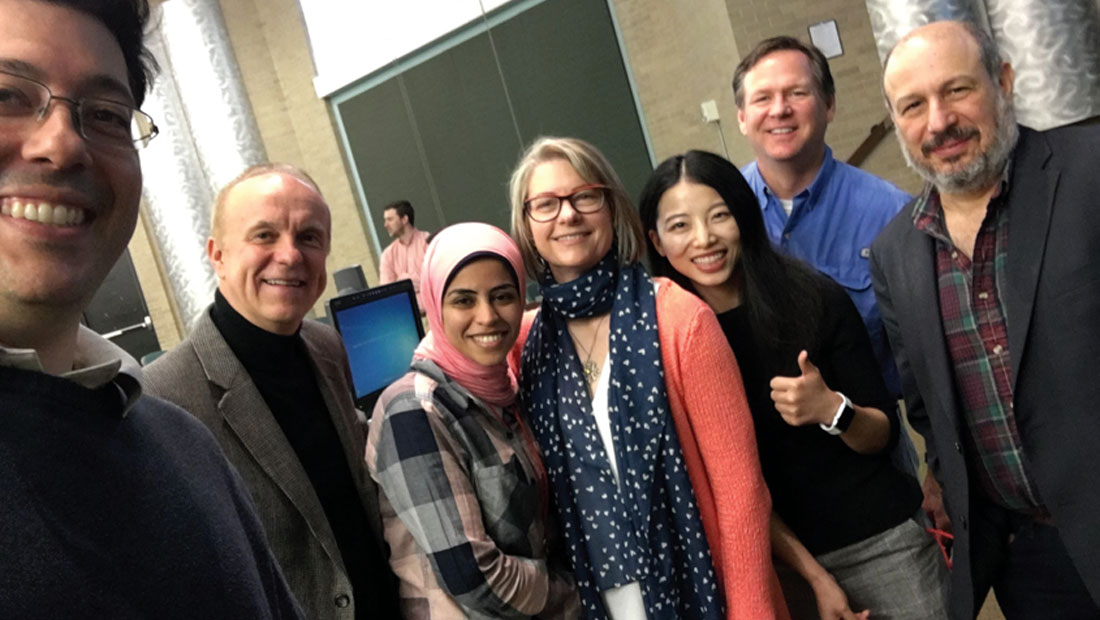
All CSEG Lecturers build their own schedules and include stops that are specific to their particular connections or areas of interest. Relatively unique elements of my tour were the non-Canadian invitations to speak at the Geophysical Society of Houston luncheons, the University of Houston, IMP (Instituto Mexicano del Petróleo) and UNAM (Universidad Nacional Autónoma de México) in Mexico City, and the USGS (US Geological Survey) in Anchorage, Alaska. These were amazing opportunities to increase exposure for the CSEG and to create a forum for shared technology and lasting international connections. Dr. Rob Stewart, Dr. Sergio Chávez Pérez, Moira Torres and Dr. Matt Haney were instrumental in making these happen.
So yes, this was a significant commitment. It was also a significant accomplishment, but, I feel slightly guilty because I think I got more out of the tour than I gave. My sincere hope, however, is that for many of the 900-odd people who saw my lecture, something I said or that came up in discussion made a difference in their day, their career, or even their lives.
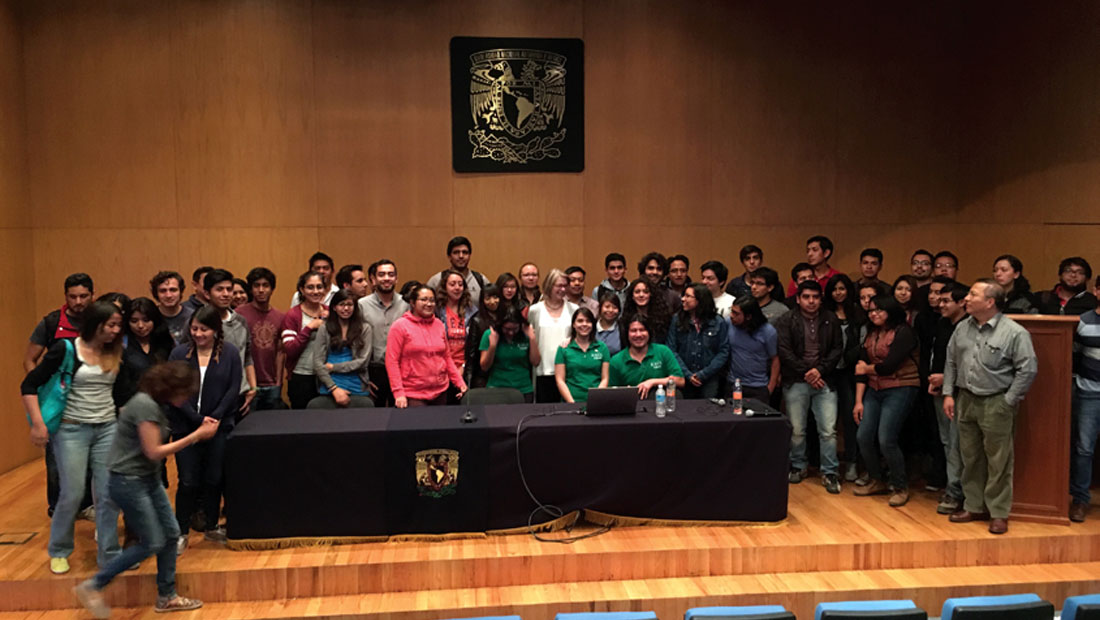
I acknowledged, by name, a few of the people who made this tour possible and successful, but there are many more whose contributions ranged from relatively minor to significant; all were influential and I wish I could thank each one again. When our paths cross sometime in the future, I will.











Join the Conversation
Interested in starting, or contributing to a conversation about an article or issue of the RECORDER? Join our CSEG LinkedIn Group.
Share This Article